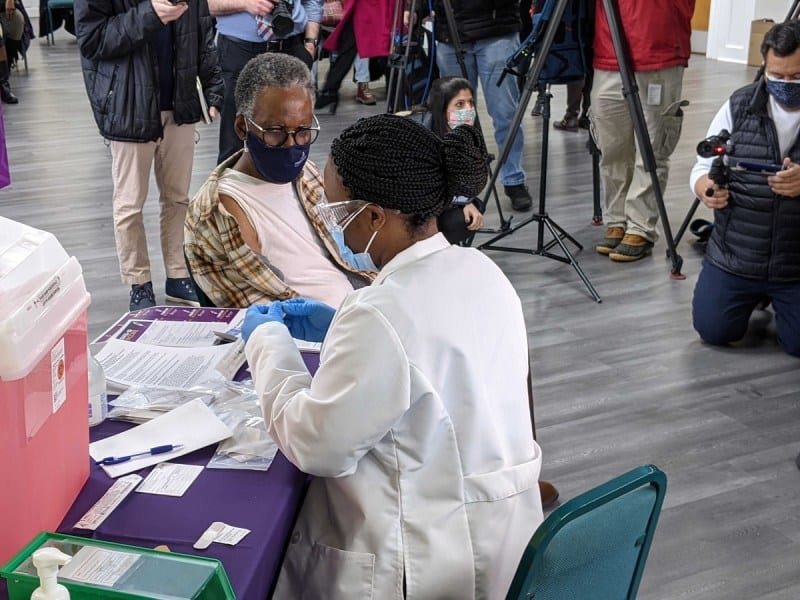Legal Aid Claims Race Discrimination in Age-Based Vaccine Distribution

Audio By Carbonatix

A resident receives the vaccine at a clinic at First Cathedral Baptist Church. Photo courtesy of CTNewsJunkie.com
As of Monday, the governor reported that half of all adults age 55 or older have received at least one vaccine dose. The most recent data for West Hartford was as of March 1, when 22.3% of the population had been administered at least one dose.
By Hugh McQuaid, CTNewsJunkie.com
Legal aid groups claim Connecticut’s largely age-based COVID-19 vaccine rollout discriminates against nonwhite people and those with disabilities and preexisting conditions in a complaint filed Monday with the U.S. Department of Health and Human Services Office of Civil Rights.
Last month, Gov. Ned Lamont announced Connecticut would abandon the Centers for Disease Control guidelines for the next phase of the state’s vaccine rollout. Lamont’s plan broadens access to the vaccine based on age, rather than a person’s medical condition or job. The governor carved out one exception for educators and child care professionals.
Frontline workers and people with preexisting conditions, who had been slated among the next to be vaccinated, have opposed the change.
On Monday a complaint filed by Connecticut Legal Services, New Haven Legal Assistance Association and the Greater Hartford Legal Aid Association asked the Office of Civil Rights to “direct Connecticut to immediately revise its COVID-19 vaccine policy” to align with the CDC recommendations by including people with high-risk jobs and underlying conditions.
“Black and brown people have higher incidence than white people of the pre-existing conditions and co-morbidities, which put them at greater risk of serious disease and death if they do contract the virus,” the lawyers wrote in the complaint.
Nonwhite residents are also more likely to contract COVID-19 and are disproportionately impacted by the shift away from vaccinating essential workers, the complaint claims.
“This is due to more often working in essential jobs which regularly expose them to the virus, as well as, due to lower incomes and discrimination, living in more tightly cramped housing and having to regularly use public transportation, public transportation that does not travel to a large number of the vaccination sites identified in the new plan,” the lawyers wrote.
Lamont has defended his plan for its focus on older individuals, who are more likely than younger people to die of complications, and its simplicity. He says it is a preferable alternative to over-broad and complicated vaccine allocation plans in other states. Asked about the civil rights complaint during a Monday press briefing, the governor repeated his reasoning.
“Rather than all the gaming you see in other states – they play games in and around their vaccine rollout, which is much more complicated – ours is based upon public health and our rollout is simple,” he said. “It says that those who are most likely to be infected, most likely to suffer complications, most likely to die are going to be the ones that get vaccinated first and that’s based on age.”
“I think we’re having some success there. We still have a ways to go,” Lamont said.
Disability Rights Connecticut filed a similar complaint with the Office of Civil Rights on behalf of people with disabilities and other underlying medical conditions in February.
So far the state has continued with its age-based approach. It lowered the age threshold for eligibility to 55 on March 1. As of Monday, Lamont said half of all residents older than 55 had been vaccinated. Meanwhile, 26% of all Connecticut adults had received at least their first doses.
Republished with permission from CTNewsJunkie.com, all rights reserved.
Like what you see here? Click here to subscribe to We-Ha’s newsletter so you’ll always be in the know about what’s happening in West Hartford! Click the blue button below to become a supporter of We-Ha.com and our efforts to continue producing quality journalism.



